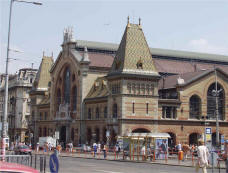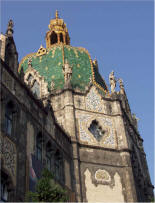|
BUDAPEST CITY SAFARI |
|
Budapest, the second
capital of the Dual Monarchy, sits on the River Danube and is composed of |
Budapest only formally came
into being in 1873 when the three smaller cities on either side of the
river were united. The Habsburg monarchy had finally recognised the
importance of Hungary in 1867 when it had become a co-partner in the
Dual Monarchy and was soon to have a capital worthy of this status.
|
The river, for centuries, had divided Budapest until 1842 when a fine chain, or suspension, bridge was planned with the impetus coming from Count Istvan Szechenyi, after whom the bridge is now named. The plans were prepared by William Tierney Clark, an Englishman, and carried out by Adam Clark, a Scotsman. This is only one of the interesting bridges, which now cross the river, restored after damage in World War 2. On the Buda side, too, are more transport remains, a tunnel at the end of the bridge designed by Adam Clark and a funicular railway which will took us to the top of the Castle Hill for fine views over the Pest side of the river. |
Other transport remains of note are the cog railway, initially constructed in 1873, only the third in the world, and the Underground opened in 1896 as the first on mainland Europe. A small museum explaining its development, housed in former underground tunnels, was also on our list of things to do. As a capital city, Budapest also boasts two fine 19th century railway termini, one by the Eiffel Company of 1884, and the Eastern Station of 1874, with statues of railway pioneers, James Watt and George Stephenson, high on the façade! |
|
Western Railway Station |
We could not undertake a Safari without looking at remains of the food industry! In Budapest there are a number of fine market buildings including the fabulous Central Market, with its façade and roof a riot of colour thanks to Zsolnay tiles from Pecs. We saw the rather sorry remains of the local meat market and abattoir of 1868 on the edge of the old city as well as a number of fine grain and malt mills close to the river. Budapest became a centre for milling, as it was a convenient place to transport grain to and from the Great Plain, and because of the availability of hardened cast iron of which to make the roller mills. Abraham Ganz, a Swiss by birth, had settled in Buda and specialised in foundry work, producing heavy casting for locomotives as well as mills. Despite all the odds, various foundry buildings still remain and are now used as a small museum devoted to the Hungarian foundry industry. |
|
Budapest Central Market |
Budapest also became noted for its fine boulevards and buildings with a new style of National Revival architecture, which featured nationalistic mosaics as well as folk patterns. Chief among the architects of the time was Odon Lechner whose buildings are now being restored after many years’ neglect. One of the finest is the Post Office Savings Bank which features bees climbing up the façade to reach their ceramic beehives on the roof. The Zsolnay company once more provided the fabulous decoration. Many of the buildings in the city are rendered, or of terra cotta or faience, as apparently, local stone is prone to weathering and so a decorative surface is more practical than a stone one! We also saw many fine banks, shops and hotels, which feature mosaics as well as fine tiling. |
|
Lechner's Museum of Applied Arts Building |



